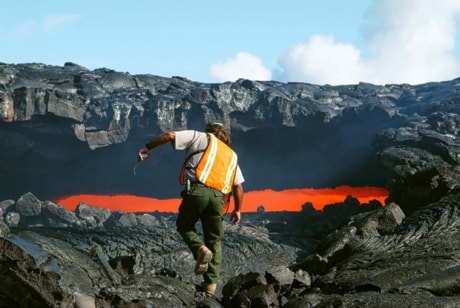HAWAII VOLCANOES NATIONAL PARK, Hawaii — The largest and southernmost of the Hawaiian islands is shaking, spitting, and stretching as it slowly expands into the ocean.
You’ll see and feel reminders of this almost everywhere during a trip to Hawaii Island, which most locals call the Big Island.
On the southern shore, streams of lava pour into the ocean where they form new land.
In some neighbourhoods, you’ll see fields of black, cooled lava that have poured from Kilauea and Mauna Loa volcanoes in recent decades.
Sometimes the ground shakes as gravity pulls on the accumulated piles of lava.
But don’t let a fear of temblors prevent you from visiting: the vast majority of these earthquakes are far too weak to feel. Big earthquakes measuring magnitude 6 or more tend to only hit the state about once a decade.
Volcanoes have been central to stories told by Hawaiians for centuries.
Legend says the volcano goddess Pele dug fire pits as she travelled from island to island looking for a home with her brothers and sisters.
She finally settled at Kilauea’s summit, where she lives at Halemaumau crater.
It’s said that Pele stomps on the floor of her fire pit when she wants to summon lava, hot rocks, steam and smoke.
You can see for yourself how Pele’s lava is building the Big Island if you visit now.
Kilauea volcano has been erupting simultaneously in two places for over a year, something that’s unprecedented in 200 years of its recorded history.
The first of these eruptions has been spilling lava across the southern part of the Big Island since 1983, swallowing roads, homes and even entire towns.
Fresh flows from this eruption are currently slithering into the ocean near Kalapana, a formerly robust town that was mostly buried in lava in 1990.
Kilauea is also erupting from Halemaumau crater at the summit. That’s where a large explosion opened a vent in March 2008, leading to the daily release of hundreds of tons of sulphur dioxide.
Kilauea has spit small fragments of lava from Halemaumau but hasn’t released any lava flows from here.
You can watch the summit eruption from a lookout point inside Hawaii Volcanoes National Park. It’s humbling to see the crater’s gas plume rise hundreds, and sometimes even thousands, of feet into the air from a vent larger than a football field.
From the visitor’s centre inside the park, you can join ranger-guided hikes to see cinder cones and now-solidified lava lakes created by previous eruptions.
Some of the walks meander through rainforests. Visitors can even venture into an old lava tube — a tunnel through which lava once streamed.
Getting near flowing lava can be dangerous, so it is vital that visitors follow guidelines set by the national park and Hawaii County.
Park ranger Mardie Lane said most visitors comply with the rules and have no problems.
But in 1993, a lava-watcher was swept away when the unstable lava bench he stood on collapsed.
Nine years ago, two visitors died after inhaling steam near a point where hot lava enters the ocean.
Hawaii County, which operates the ocean entry lava viewing point near Kalapana, outside the park, has designated a safe lava viewing area and cordoned off fragile lava benches.
Don’t be disappointed if you are prohibited from standing next to the lava flow. Watching lava slide into the ocean is powerful even from a distance.
At the Hawaii County lava viewing point one recent evening, a few dozen visitors oohed and aahed as they watched a large steam plume rise into the air as scalding hot lava hit the chilly sea near Kalapana.
The plume glowed pink whenever lava slithered into the ocean from an above-ground lava tube prompting viewers to gasp and murmur.
County workers on duty at the viewing site have spent most of their lives next to lava.
Emily Hauanio saw her hometown of Kapaahu submerged in molten rock in the 1980s. She says Pele was cleansing the land so she wasn’t upset.
“There was a lot more people coming in. Our famous swimming holes were getting polluted,” said Hauanio, a Hawaiian whose family has lived in the area for generations. “It was time for her to come in and clean up the mess. That’s the way I felt. And that’s what she did.”
Another county guide, Malia Mendes, whose grandmother’s home was one of the only Kalapana structures spared by lava, was also accepting.
“It’s nature’s way. It was meant to be,” said Mendes, who is also Hawaiian.
